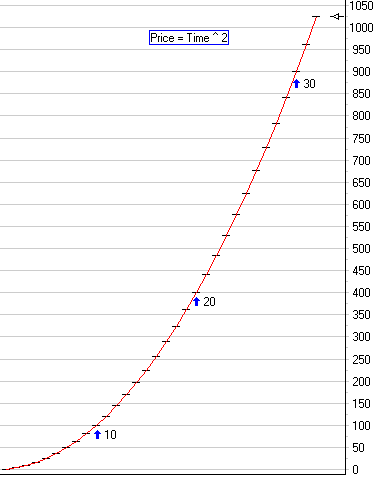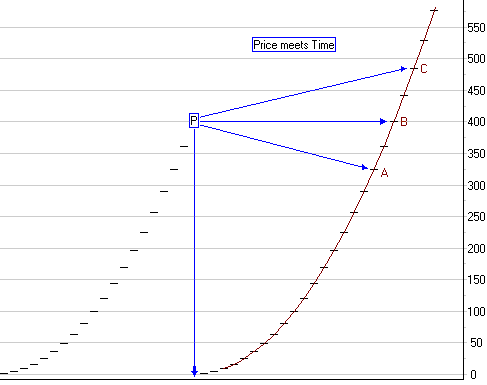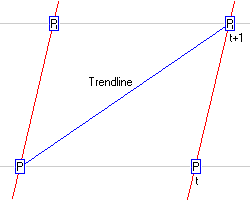by Howard Arrington William D. Gann (1878-1955) was a legendary trader who designed several unique techniques for analyzing price charts. He developed a unique combination of precise mathematical and geometric principles which are not easy to grasp. Gann analysts have spent years pouring over old charts and writings in search of Gann's secret, and there is no end to the number of people who claim to have discovered Gann's insight and technique that has eluded everyone else. Perhaps someone has discovered it. I am not in a position to appraise all the claims because I am not a Gann expert and have not read Gann's writings. Don Hall has published a book and developed a system called Pyrapoint which seems to me to be well founded in Gann principles. The purpose of this article is to take one idea used in Don's work, and present it from a different approach, and yet arrive at the same useful conclusion. I hope even Don will find my article to be an original insight to substantiate the validity of his work. Gann's geometric angles are trend lines drawn from prominent tops or bottoms at certain angles. The most important angle is 45 degrees, which means the line's slope is one unit of price per unit of time. (Note: Depending of the chart scale used, the line may or may not appear to be plotted at a 45 degree angle.) For years, I thought this is what Gann analysts meant by the phrase 'squaring time and price.' However, Don's Pyrapoint method gave me a new insight, which is: Price = Time squared or P = t ^ 2 Let me take this mathematical relationship and develop it in this article. The above relationship between price and time can be plotted on a chart as shown in this illustration. The time values of 10, 20, and 30 are marked by the three arrows.
For the sake of illustration, let's suppose a prominent top or bottom occurs at a price of 400. The theory is that this significant point has a mathematical counterpart. Start a new time curve at this point in time, and it will give us an expectation for a future top or bottom to occur on this curve. This principle can be stated as 'When price meets time, a change is imminent.' This 'price meets time' relationship is shown in the following chart.
With the prominent top or bottom at P, if price meets the curve at point A it will do so in 18 bars. The time to A is the square root of the price at A. Price at A is 324. Square root of 324 is 18. If price meets the curve at point B, it will do so in 20 bars. The time to B is the square root of the price at B. Price at B is 400, therefore the time to B is 20 bars. If price meets the curve at point C, it will do so in 22 bars. This is a very interesting concept! Remember that price and time are related by the formula: P = t ^ 2 or t = sqrt( P ) Research: by Howard Arrington In this article, I will develop the mathematics for the slope of a trend line using the price and time relationship presented in the previous article. Let's work with the model illustrated in this figure.
From the previous article, the next time curve will be t bars away for a given price P. At a time t+1 price would meet the curve at price P1. Now, lets solve for the slope of the trend line shown in blue which connects P and P1. P = t ^ 2 Slope = (Change in price) / (Change in time) Change in price = P1 - P = P + 2 t + 1 -
P = 2 t + 1 = 2 t + 2 - 1 = 2 [ t + 1] -1 Therefore, slope of P to P1 is = (2 [ t + 1] - 1) / (t+1) = 2 - 1 / (t+1) = 2 - 1 / sqrt( P1 ) If we normalize all prices to consider three significant digits, then all prices will fall in the range of [100 ... 1000]. By substituting the price boundaries into the slope formula, we can get a range of slopes as follows. For a P1 of 100, the slope of the up trend
line to 100 = 2 - 1 / 10 = 1.9 Let's call this trend line a 45 degree line because we developed the slope using one unit of price change from P to P1 with one unit of time t. For this 45 degree line, the slope is basically 2. I think this is strong justification as to why Gann used 2 cents as the price grid interval of his daily grain charts. Such a scale layout would naturally give Gann 45 degree angles with a slope of 2 cents per daily bar. I have shown that 2 is the slope of the upward 45 degree trend line that develops from the price and time relationship given by the formula: P = t ^ 2. One can solve for the slope of the downward trend line from P1 to P to obtain this result: Slope of P1 to P = (-2 t - 1) / (t-1) = (-2 [t - 1] - 3 ) / (t-1) = -2 - 3 / (t-1) = -2 - 3 / (sqrt( P ) - 1) For a P of 100, the slope of the down trend
line to 100 = -2 - 3/9 = -2.33 Again, the slope of the down trend line approaches a value of -2. Therefore, -2 is a good approximation for the slope of a downward 45 degree trend line. |


